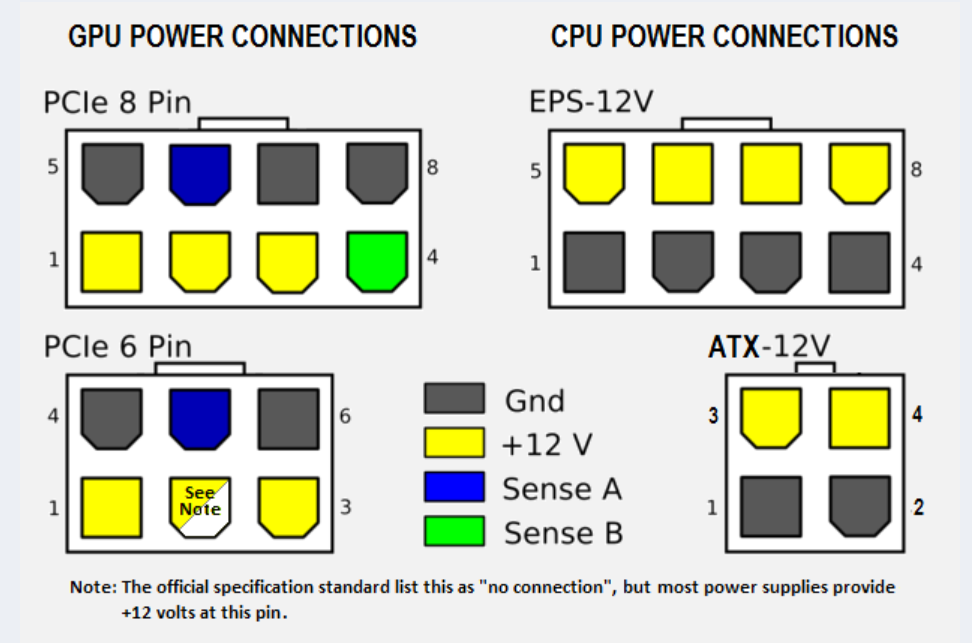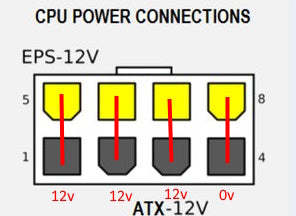Atx CPU 8 Pin Pinout
The ATX CPU 8-pin pinout is a crucial component in modern computer systems. This small but mighty connector plays a vital role in delivering power to the CPU, ensuring optimal performance and stability. With its intricate design and precise power delivery capabilities, the ATX CPU 8-pin pinout has become a standard feature in most high-performance computers.
The history of the ATX CPU 8-pin pinout dates back to the early 2000s when AMD introduced the Athlon 64 processor. This revolutionary CPU required more power than its predecessors, and a new power connector was needed to meet this demand. The ATX CPU 8-pin pinout was then developed to provide a reliable connection between the power supply and the CPU. Today, this connector remains a critical component in modern computing systems, ensuring efficient power delivery and contributing to the overall stability and performance of the computer.
The ATX CPU 8-pin pinout refers to the standardized power connector used to supply power to the CPU in a computer system. This connector provides a reliable and efficient power delivery to the CPU, ensuring optimal performance. It is important to connect this pinout correctly to avoid any damage to the CPU or motherboard. Refer to the motherboard's manual or documentation for the specific pinout configuration. Proper installation and connection of the ATX CPU 8-pin pinout is crucial for the stability and longevity of the system.

Understanding the ATX CPU 8 Pin Pinout
The ATX CPU 8 pin pinout is an essential component of modern computer motherboards. It is responsible for providing power to the CPU, ensuring its efficient operation. The pinout consists of eight pins arranged in a specific configuration. Each pin serves a unique purpose and must be properly connected to ensure the stability and performance of the CPU. This article will delve into the details of the ATX CPU 8 pin pinout, exploring its functions and the importance of proper wiring.
Pin Configuration of the ATX CPU 8 Pin Pinout
The ATX CPU 8 pin pinout follows a standardized configuration to ensure compatibility across various motherboards and power supply units. The pin configuration is as follows:
| Pin Number | Function |
|---|---|
| 1 | 12V CPU |
| 2 | 12V CPU |
| 3 | Ground |
| 4 | Ground |
| 5 | Ground |
| 6 | Ground |
| 7 | 12V CPU |
| 8 | 12V CPU |
The pins numbered 1, 2, 7, and 8 provide the necessary voltage for the CPU, while the pins numbered 3, 4, 5, and 6 are used for grounding. It's crucial to connect them correctly for the CPU to function optimally. Power supply units and motherboards typically have dedicated connectors for the ATX CPU 8 pin pinout, making it easier to ensure proper connections.
It is essential to differentiate the ATX CPU 8 pin pinout from the ATX CPU 4+4 pin pinout. While they serve the same purpose of supplying power to the CPU, the latter has an additional four pins that allow for flexibility when using different power supply units. The ATX CPU 8 pin pinout is more common in modern motherboards, but some older models may still use the ATX CPU 4+4 pin pinout.
Importance of Proper Wiring
Proper wiring of the ATX CPU 8 pin pinout is critical for the stability and performance of the CPU. Any loose or incorrect connections can lead to power fluctuations, overheating, or even damage to the CPU and other components. When connecting the ATX CPU 8 pin pinout:
- Ensure that the power supply unit and motherboard connectors match the pinout configuration.
- Align the pins correctly and gently insert the connector to avoid bending or breaking the pins.
- Make sure the connector clicks into place securely, ensuring a stable connection.
- Avoid applying excessive force when connecting or disconnecting the pinout.
Using a modular power supply unit can help simplify the wiring process, as it allows for easy replacement and customization of cables. Modular power supply units have separate cables for the ATX CPU 8 pin pinout, minimizing the risk of confusing connections.
Furthermore, it is essential to choose a power supply unit that can provide sufficient power to the CPU. Insufficient power supply can result in system instability, crashes, or even damage to the CPU. Consult the motherboard and CPU specifications to determine the required power rating and choose a power supply unit accordingly.
Common Issues and Troubleshooting
While wiring the ATX CPU 8 pin pinout correctly is crucial, issues can still arise in certain circumstances. Here are some common issues and possible troubleshooting steps:
1. Loose Connection
If the CPU is experiencing intermittent power loss or system instability, it is essential to check the connection of the ATX CPU 8 pin pinout. Ensure that the connector is firmly plugged into both the power supply unit and the motherboard. If necessary, unplug and reinsert the connector to establish a secure connection.
2. Bent or Broken Pins
If any of the pins in the ATX CPU 8 pin pinout are bent or broken, it can lead to poor contact or no contact at all. In such cases, the connector may need to be replaced. Carefully inspect the pins and, if necessary, consult the manufacturer or a professional for assistance in obtaining a replacement connector.
3. Inadequate Power Supply
If the CPU is not receiving enough power, it can result in system instability or failure to boot. Check the power supply unit's specifications and ensure that it can provide sufficient power for the CPU. Consider upgrading to a higher-rated power supply unit if necessary.
Remember to consult the motherboard and CPU documentation for specific troubleshooting steps and recommendations. In complex situations, it is advisable to seek assistance from a professional technician to avoid further damage to the components.
Using the ATX CPU 8 Pin Pinout Safely and Effectively
The ATX CPU 8 pin pinout is an essential component for powering the CPU in modern computer systems. Understanding its pin configuration, importance of proper wiring, and troubleshooting common issues is crucial for ensuring stable performance and avoiding damage to the CPU and other components. By following the correct wiring procedures and using a suitable power supply unit, computer enthusiasts can harness the full potential of their CPUs and enjoy a seamless computing experience.

Understanding the ATX CPU 8 Pin Pinout
The ATX CPU 8 pin pinout refers to the connection layout of the power supply connector that provides the necessary power to the central processing unit (CPU) in a computer. This pinout is commonly found on ATX motherboards and is crucial for the stable and reliable operation of the CPU.
The ATX CPU 8 pin pinout consists of a single connector with eight pins. Each pin has a specific purpose, which ensures proper power distribution and communication between the power supply and the CPU. It provides both power and ground connections to the CPU, as well as dedicated voltage rails for different components within the CPU.
The pinout can vary slightly depending on the manufacturer and model of the motherboard, but generally, it follows a similar pattern. It is important to consult the documentation or manual specific to your motherboard to ensure the correct pinout configuration. Connecting the ATX CPU 8 pin incorrectly can result in system instability or damage to the CPU or motherboard.
To properly connect the ATX CPU 8 pin, align the connector with the socket on the motherboard, and gently push it in until it is fully seated. The pins should align with the corresponding holes in the socket. Ensure a secure connection, but avoid applying excessive force.
In conclusion, understanding the ATX CPU 8 pin pinout is essential for proper power distribution and optimal performance of the CPU. Refer to the motherboard documentation for the correct pinout configuration, and take care when connecting the power supply to avoid any potential damage.
Key Takeaways: ATX CPU 8 Pin Pinout
- The ATX CPU 8 Pin pinout is a connector used to provide power to the processor in a computer system.
- It consists of eight pins that deliver the necessary voltage and current to ensure the processor operates efficiently.
- The ATX CPU 8 Pin pinout is a standardized connector found on most modern motherboards.
- Each pin has a specific function, including delivering power to the core voltage, ground, and sense signals.
- It is important to ensure that the correct pins are connected properly to avoid any damage to the processor or motherboard.
Frequently Asked Questions
Here are some commonly asked questions about the Atx CPU 8 Pin Pinout:
1. What is the purpose of the Atx CPU 8 Pin Pinout?
The Atx CPU 8 Pin Pinout is used to provide power to the CPU of a computer. It delivers the necessary voltage and current for the CPU to operate properly. This pinout ensures a stable and reliable power supply to the CPU, which is vital for its performance and longevity.
2. How is the Atx CPU 8 Pin Pinout connected to the motherboard?
The Atx CPU 8 Pin Pinout is connected to the motherboard's CPU power connector. It is usually located near the CPU socket on the motherboard. The pinout has a specific configuration that matches the corresponding pins on the motherboard's CPU power connector, ensuring a secure and correct connection.
3. Can I use a 4-pin CPU power connector with the Atx CPU 8 Pin Pinout?
No, the Atx CPU 8 Pin Pinout is designed to be used with an 8-pin CPU power connector. While it may be tempting to use a 4-pin connector, it is not recommended as it may not provide enough power and stability to the CPU. It is important to use the correct power connector to ensure proper operation of the CPU and avoid any potential damage.
4. Can I use an Atx PSU with a different pinout for the CPU power connector?
No, it is not recommended to use an Atx PSU with a different pinout for the CPU power connector. The pinout is designed to match the corresponding pins on the motherboard's CPU power connector. Using a different pinout may result in an incorrect connection, which can cause damage to the CPU or other components. It is important to use a compatible PSU and ensure that the pinout matches the motherboard's requirements.
5. Are there any precautions to consider when connecting the Atx CPU 8 Pin Pinout?
Yes, there are a few precautions to consider when connecting the Atx CPU 8 Pin Pinout:
- Ensure that the power is completely turned off and unplugged before making any connections.
- Ensure that the pinout and motherboard's CPU power connector match before making the connection.
- Gently insert the pins into the corresponding connector, ensuring a secure and correct connection.
- Do not force the connection; it should fit easily and align properly.
- Double-check the connections and ensure that they are secure before turning on the power.
CPU Power Cable Guide - Understand What You Need!
In conclusion, the ATX CPU 8 pin pinout is an essential aspect of computer hardware. It provides the necessary power supply to the CPU, ensuring optimal performance and stability.
Understanding the pinout diagram is crucial for correctly connecting the CPU power cable to the motherboard. This ensures that the CPU receives the necessary power to operate efficiently. Always refer to the motherboard and CPU manuals for the correct pinout configuration.































